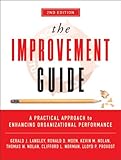Lean Six Sigma in the commercial medical laboratory outreach industry: A case study approach
The book reviews the various options that a company in the Medical Laboratory industry has in regards to the deployment of Lean Six Sigma. It starts with a review of the history and the current environment of health care in the USA, then proceeds to the various sub-specialties and the most important tests. It then reviews the various options of deploying Lean Six Sigma followed by a closer review of the main tenets of Lean and the Toyota Production system as well as Value Stream Management. Various case study using the DMAIC (Define, Measure, Analyze, Improve and Control) methodology demonstrate the power of the Lean Six Sigma methodology in improving the quality of Medical Laboratories and reducing costs without compromising quality.
List Price: $ 25.00
Price: $ 25.00
The Improvement Guide: A Practical Approach to Enhancing Organizational Performance (Wiley Desktop Editions)
This new edition of this bestselling guide offers an integrated approach to process improvement that delivers quick and substantial results in quality and productivity in diverse settings. The authors explore their Model for Improvement that worked with international improvement efforts at multinational companies as well as in different industries such as healthcare and public agencies. This edition includes new information that shows how to accelerate improvement by spreading changes across multiple sites. The book presents a practical tool kit of ideas, examples, and applications.
List Price: $ 55.00
Price: $ 38.44
Check This:
 A Slice of Six Sigma DVD: An easy-to-understand introduction for non-statisticians
A Slice of Six Sigma DVD: An easy-to-understand introduction for non-statisticiansA lot of people shy away from learning and using Six Sigma as part of their Continuous Improvement efforts because they think it r…
 Six Sigma for Green Belts and Champions: Foundations, DMAIC, Tools, Cases, and Certification
Six Sigma for Green Belts and Champions: Foundations, DMAIC, Tools, Cases, and Certification“Much has been said or written in recent times about the value of Six Sigma methodologies in driving organizational improvement. Y…
 Statistics for Six Sigma Green Belts with Minitab and JMP
Statistics for Six Sigma Green Belts with Minitab and JMPThis is the eBook version of the printed book.The only book on the market that provides a simple nonmathematical presentation of t…




A simple and easy to use methodology for making improvements,
The Improvement Guide has brought to our business and my life a simple and easy methodology for making improvements regardless of the scope of the process.
The guide is based on a systems approach to improvements, which allows a better understanding of how the improvements that you are working on effect your system.
I teach an operations class and I use this book and its ideas as a semester long improvement project. The students have come to understand that an improvement must begin with an objective for the improvement and that you run a cycle (plan, do, study, act) to test your prediction. The students have commented they really enjoy learning this methodology and can easily apply it to their daily lives.
The book is easy to read and has useful examples of real life improvement efforts. I use this book on a daily basis. It allows me the opportunity to manage our company’s, my students as well as my own improvement efforts.
Was this review helpful to you?

|The Answer to Dr. Deming’s question: “By What Method?”,
Dr. W. Edwards Deming, whose management ideas and Profound Knowledge provide the theoretical underpinnings of this book, continually asked the question to anxious audiences: “By what method? How do you go about it?” As a professional in the quality sciences field, I believe this book has the answer to those questions as it relates to improvement. The Improvement Guide defines improvement and describes in complete detail workable, easy to use techniques that are effective and time-tested. The book is based around the Improvement Model, an expanded and improved version of the Deming-Shewhart cycle, whose historical roots trace are grounded in applications of the scientific method and applied scientists since Roger Bacon. The principle of testing on a small scale, learning using the Plan-Do-Study-Act cycle, and building knowledge sequentially using the Improvement Model are some of the most practical and useful aspects of the book. Part I is written on an introductory level and provides lots of simple examples that guide the beginner through theory and practice. The heart of the book, and some of its most useful content, describes ways to develop, test, and implement a change. The insights provided, based on decades of experience and knowledge of the authors, are invaluable. They are followed up by thoroughly documented and easy to understand case studies that ring true using real life examples related to manufacturing, services, health care, and a variety of standard business and educational processes. Finally, the third section describes an integrated approach to various standard improvement goals and useful strategies for achieving them. This section also includes extremely insightful guidance for leaders trying to promote and enable improvement, and an innovative and thought-provoking section suggesting techniques for expanding customer expectations to increase demand for products and/or services. This section, too, is replete with examples and case studies to support and illustrate methods and concepts.
This book should be studied by anyone, beginner or experienced professional, interested in a systematic method for improving processes, products, or services. I strongly recommend it.
Was this review helpful to you?

|Improvement viewed as a science.,
Whether involved with improving products/processes within a business or coaching little league baseball, The Improvement Guide provides a practical and fundamental approach for improving performance. The book serves as an excellent reference for those involved with change, specifically, change that will result in improvement.
A few of the items from the book which ring in my mind continuously include:
Improvement can be viewed as a science (in fact, some of us do!).
Three questions provide the framework for improvement: 1. What are we trying to accomplish? 2. How will we know if we if a change will result in an improvement? 3. What changes can we make that will result in improvement?
While there are many opportunities to change, there are only 70 change concepts (included in the Appendix) available to us today.
Any system for improvement will include five activities: 1. Establishing and communicating the purpose of the organization/team. 2. Viewing the organization/team as a system. 3. Designing and managing the a system for gathering information for improvement 4. Planning for improvement and integrating it with business planning. 5. Managing individual and team improvement activities.
Leaders are required to implement change that will result in improvement and they draw their power from three sources (the informal leader gets his/her power from sources 2 and 3 below). 1. Authority or position 2. Knowledge 3. Personality and persuasiveness (caring about people)
These items and many more, are introduced in the book via an easy-to-understand model that uses proven methodology for developing, testing, and implementing change that produces specific, identifiable improvements.
Was this review helpful to you?

|